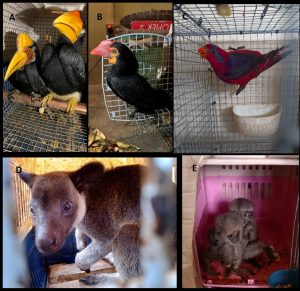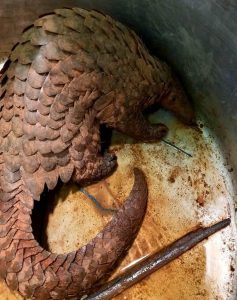Uttam Saikia and H. C. Chaudhary draw attention to the darkside of illegal wildlife trade during World Wildlife week.
“Earth provides enough to satisfy every man’s needs but not every man’s greed”. This quote by Mahatma Gandhi aptly reflects the mindless desires based on greed of the ‘modern world’ which is even driving the very existence of humankind to the edge! Since time immemorial, human society has been dependent on nature to meet its needs and nature has had enough resources to ensure that Homo sapiens remain satiated and also protected from its elements. By dint of superior brain development, modern humans decided to surpass archaic human races and other animal species to become the most dominant global force capable of tweaking the environment on a massive scale. The result as we see today is a catastrophe. Biodiversity of the Earth is at the lowest ebb; our planet is impoverished like never before. Wildlife trade is one of the many destructive tools employed by humans driving these kinds of unparalleled impoverishment. By definition, wildlife trade refers to the trade of non domesticated animals or plants that are derived from their natural environment or raised in a controlled environment. While this trade can be legal to some extent governed by certain multilateral treaties like The Convention on International Trade in Endangered Species of Wild Fauna and Flora (CITES), an overwhelming chunk of wildlife trade is illegally conducted surreptitiously. Illegal wildlife trade is also one of the most pressing conservation challenges as it depletes natural populations of wild plants and animals at a rate nature is incapable of replenishing.
An over demand driven market: the extent of illicit wildlife trade: The global trade of wildlife articles is considered to be one of the largest illegal trades running into billions of US dollars. Due to the nature of the trade, it is impossible to know the exact monetary value of this trade but estimates vary between 7-23 billion US dollars every year making wildlife crime the fourth largest illegal global trade, behind only narcotics, counterfeiting, and human trafficking (Zoological Society of London, 2023). The visible local markets in Asian and African countries selling bushmeat or other wildlife products constitute a minuscule portion of wildlife trade. Most often, these trades are controlled by well organised international criminal syndicates with sophisticated modus operandi akin to illicit arms and drug trade. Although many charismatic vertebrates or plant species are major victims of this trade, there are countless other species not protected by any legal framework which may also be illegally harvested and trafficked. A large proportion of this trade is contributed by poached animal carcasses and their numerous body parts which are in demand for their purported medicinal value. For example, the rhino horn, tiger body parts, pangolin scales, and tokay geckos invariably command a very high price in the black market, some of which are ingredients in Chinese traditional medicine. Carved ivory items are considered as a high end art and the booming middle class in China and other Asian countries ensures the demand for ivory never declines. As per well publicised studies, poaching of African elephants was found to be correlated to the rising demand for ivory in the Chinese market (Hauenstein et al. 2019) There is also a huge demand for live animals fuelled by the desire of wealthy clients to possess exotic pets or rare plants and the recent seizure of exotic animals in northeastern India is a proxy indicator of this.
Ill-effects of illegal wildlife trade: Wildlife crime can have a broad range of ill-effects on climate change to preservation of biodiversity, biosecurity and public health. Poaching and trading of animals and plants is a major driver of biodiversity impoverishment globally. According to a report (National Geographic, 2019), over 31000 species of vertebrates are traded illegally out of which about one fourth are traded globally driving them to extinction. The consequences of unethical demand and consumption of wildlife products is invariably dire on the species. To cite a few examples, the total population of two species of African rhinoceros currently stands slightly over 22000 animals (www.savetherhino.org).
Extent of wildlife trade in India: Wildlife crime is a worldwide problem although it is much pronounced in the Global South’s developing countries of Asia, Africa and Latin America. Having been a biodiversity rich country, India has a fair share in this illegal trade and reportedly features among the top twenty countries for wildlife trafficking (www.wildlifesos.org). A number of wild animals and plants and their parts are regularly exploited and traded in India most of which have no direct demand in the country and meant for the illegal markets elsewhere.
According to the World Wildlife Fund (WWF), a diverse array of items like mongoose hair; snake skins; Rhino horn; Tiger and Leopard claws, bones, skins, whiskers; Elephant tusks; deer antlers; pangolin scales, tongue and internal organs of tokay gecko, shahtoosh shawl; turtle shells; musk pods; bear bile; medicinal plants; timber and caged birds such as parakeets, mynas, and munias are illegally traded in India. In fact, the country’s northeastern states are used as conduits by unscrupulous elements for transiting of exotic animals from SouthEast Asia and beyond. It is noteworthy that there has been a recent spurt of seizures of exotic wildlife by law enforcing agencies in Meghalaya and Assam while in transit. Apparently, these items, mostly live birds and mammals native to Southeast Asian countries and sometimes as far as Brazilian Amazon forest cross over to India through the porous Myanmar border and destined for clients in mainland India and abroad. Data on wildlife trade and confiscation is scanty, but according to a report by TRAFFIC (a leading non-governmental organisation in UK working to ensure that trade in wild species is legal and sustainable for the benefit of the planet and people), the wildlife trade monitoring agency of WWF India, during the period 2018-22, at least 1200 individuals of Pangolins were involved in illegal trafficking in India. This is based on confiscation data, trafficking that goes undetected will surely add up significantly to this number. It may be mentioned that in one of the largest seizures in April, 2021, joint teams of Wildlife Crime Control Bureau, Meghalaya Forest Department and Meghalaya Police confiscated four live pangolins, about 44 kg of pangolin scales and 43 Tokay Gecko. These are huge numbers considering the small wild populations of these highly threatened species. According to a report of Wildlife Conservation Society-India, ungulates (hoofed mammals) feature in the top followed by large cats and pangolin in wildlife poaching and illegal trade cases in India during 2020. Non native animal species crossing the Indian border are also very frequent as TRAFFIC data for 2022 shows that about 4000 exotic animals were seized in that year. Alarmingly, many of these seizures are from the northeastern states of India dominated by Mizoram.
The CITES and wildlife trade: CITES is an international treaty that aims to ensure that international trade in specimens of wild animals and plants does not threaten the survival of the species. The convention came into force in July, 1975 with its secretariat based in Geneva. The idea of CITES was mooted to prevent endangerment of wild species due to overexploitation and trade. Since many of these species are traded through trans-border movement, international cooperation was needed to control this. The signatory countries to this convention have voluntarily agreed to abide by the convention and are known as parties. At present, CITES has 183 parties and India is one of the earliest signatories to it. Over 40000 species of plants and animals are protected against overexploitation by international trade through their inclusion in various appendices of CITES. The species listed in Appendix I of the convention are threatened with extinction and trading of these species is permitted only under exceptional circumstances. CITES works by subjecting international trade in specimens of selected species to certain controls. All import, export, re-export and introduction from the sea of species covered by the Convention has to be authorised through a licensing system administered by a designated authority of the parties (for details pls visit https://cites.org/eng)
Enforcement beyond seizures: Any law will have the desired impact only when implemented effectively. It is common knowledge that many times; the criminals exploit loopholes in the legislative and enforcement part and go scot-free. It is paramount that wildlife crime is considered a serious offence both by the policy makers and the law enforcing agencies. India has a tough wildlife law in the form of the Wild Life (Protection) Act, 1972 which was recently amended according protection to about 1995 species of native plant and animal species. According to Wildlife Crime Control Bureau data, between 2012-18, over 9000 persons were arrested in India for poaching related crimes but the conviction rate stands at a measly 2 percent! One of the reasons for this very low rate of conviction is the inability of the law enforcement agencies to build a watertight case as it has to withstand the scrutiny in the court of law. It is therefore crucial to build capacity among the enforcement personnel in wildlife crime detection and preparing a fool proof court case. Sensitising the judiciary about the nuances and intricacies of the Act, and the plight of wildlife can go a long way in having a more aware judge presiding over the case as pointed out by Wildlife Conservation Trust, a prominent conservation organisation. A considerable number of these cases involve trade in exotic plants and animals that are outside the purview of the Wild Life (Protection) Act, 1972 rendering conviction difficult. However, as mentioned above, the majority of the exotic species in trade are covered by CITES and India being a signatory, has statutory obligations to implement CITES at the national level. Fortunately, the amended WPA in 2022 included all the wildlife species in various sections of CITES as Schedule IV of the Act indicating their trade is highly regulated now and enforcement agencies can now take actions in violation of the provisions of CITES. Wildlife trade being a low risk and high gain business, is a tempting profession. Hence, strict law enforcement is necessary to deter poachers and traffickers to ensure continued survival of wild plants and animals. After all, the larger ecosystem that we live in today, we will also leave for our children.
About the authors: Uttam Saikia is a senior scientist at Zoological Survey of India, Shillong and H. C. Chaudhary is the Principal Chief Conservator of Forest (Working Plan, Research & Training and District Council Affairs) and Former Chief Wildlife Warden Govt. of Meghalaya. The views expressed are personal.

Plate 1: Exotic animals confiscated by Meghalaya Forest Department recently. A: Knobbed hornbill and Rhinoceros hornbill B: Writhed hornbill C: Red and Blue Lory D: Lumholtz’s tree-kangaroo E: Young Javan Gibbon. Photo Courtesy: N Laloo, DFO and L. Wahlang, R.O., Meghalaya Forest Department

Plate 2: Confiscated Chinese Pangolin, a Critically Endangered species and one of the most illegally trafficked mammal species in the world. Photo credit. Uttam Saikia



